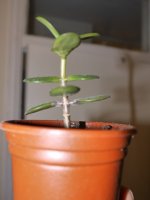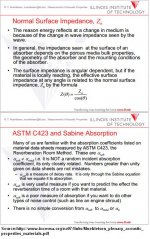problem solved. I am still working on it...
HL Mencken: "It is difficult to get a man to understand something when his salary depends upon his not understanding it."
Why?
Most of the acoustic modeling programs only use one number for the coefficient of absorption. Most material is rated for a single number. Does anyone here know what that number is supposed to represent?
Interesting questions Ed. Please expand on this.
ASTM C384 Standard Test Method for Impedance and Absorption of Acoustical Materials by Impedance Tube Method
1.1 This test method covers the use of an impedance tube, alternatively called a standing wave apparatus, for the measurement of impedance ratios and the normal incidence sound absorption coefficients of acoustical materials.
Estimates of the random incidence or statistical absorption coefficients for materials can be obtained from normal incidence impedance data. For materials that are locally reacting, that is, without sound propagation inside the material parallel to its surface, statistical absorption coefficients can be estimated from specific normal acoustic impedance values using an expression derived by London. Locally reacting materials include those with high internal losses parallel with the surface such as porous or fibrous materials of high density or materials that are backed by partitioned cavities such as a honeycomb core. Formulas for estimating random incidence sound absorption properties for both locally and bulk-reacting materials, as well as for multilayer systems with and without air spaces have also been developed
ASTM C423 Standard Test Method for Sound Absorption and Sound Absorption Coefficients by the Reverberation Room Method
1.1 This test method covers the measurement of sound absorption in a reverberation room by measuring decay rate. Procedures for measuring the absorption of a room, the absorption of an object, such as an office screen, and the sound absorption coefficients of a specimen of sound absorptive material, such as acoustical ceiling tile, are described.
George
That's a very nice jade plant.
Thank you.
The answer is buggerall in terms of energy absorption.
Whatthehell you talking about?
Boy, am I ever cranky these days. For a domestic living space, as you know I'm sure, carpet absorbs little or no lf and as f increase the amount of absorption increases. But not nearly enough, fast enough.
Most folk who want to absorb floor reflections emprically arrive at doing something like putting in front of speaker a duvet on top of some pillows, or a small rug on top of some pillows.
Terms of listening experience, what is needed is cutting that first early floor reflection way down so it doesn't participate in precedence effect colouring, (which can include the floor bounce cancellation you see with stand mounted speakers).
In domestic rooms precedence effect of reflections and room modes are a huge big deal but what to do about them is pretty straight forward and well known.
http://www.diyaudio.com/forums/loun...ch-preamplifier-part-ii-1201.html#post4189032
George are we biting at trolled lures?
Last edited:
In fact, I have known a number of speaker designers who seem to be so obsessed (and sensitive) to speaker problems, that they regard electronics as a minor departure from total realism.
John would you say this problem is mainly down to the infatuation with the current set of measurements, in particular THD? Even though Geddes's work demonstrates THD is totally irrelevant to speakers, those who focus on speakers do tend to justify that in saying speaker distortion is orders of magnitude greater than that of electronics, hence the former are more in need of work than the latter.
I am one and its because (as far I can figure out) speakers don't introduce modulation noise, but electronics (particularly poorly decoupled opamps) do.This is unfortunate, because there are people who can hear the electronics 'signature' through relatively poor loudspeakers, and even better with better loudspeakers, and I know that there are several here on this thread.
Last edited:
That's the name of game, yes - speakers, lots of distortion but generally very benign, doesn't get in the way of subjective enjoyment; electronics, possibly very low level, subtle in the measuring, but unpleasant or deadening of the pleasure for the ears ...I am one and its because (as far I can figure out) speakers don't introduce modulation noise, but electronics (particularly poorly decoupled opamps) do.
That's a very nice jade plant.
When I met my wife she still had her jade plant propagated from the 70's.
The distortion in speakers gets lower and lower with decreasing level, just like analog tape. At realistic listening levels, the distortion may be fairly low. NO Xover distortion!
There's plenty of class A SS amps out there.
Of possible interest, this is a subjective review of an amplifier that tells me a lot, in a positive sense, about its capabilities - the clues are there that it shows "correct" behaviour: Classé CT-M600 & CA-M600 monoblock power amplifiers Page 2 | Stereophile.com
John would you say this problem is mainly down to the infatuation with the current set of measurements, in particular THD? Even though Geddes's work demonstrates THD is totally irrelevant to speakers, those who focus on speakers do tend to justify that in saying speaker distortion is orders of magnitude greater than that of electronics, hence the former are more in need of work than the latter.
I am one and its because (as far I can figure out) speakers don't introduce modulation noise, but electronics (particularly poorly decoupled opamps) do.
Don't forget Geddes is very strong about the undesirability of crossover distortion.
- Status
- Not open for further replies.
- Home
- Member Areas
- The Lounge
- John Curl's Blowtorch preamplifier part II

